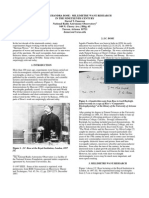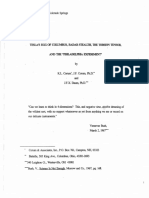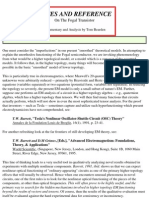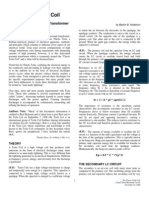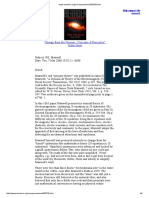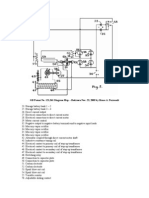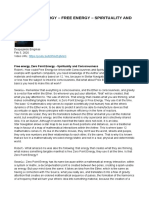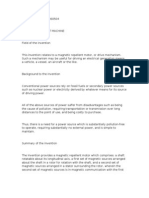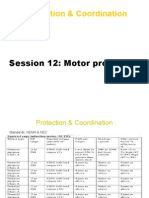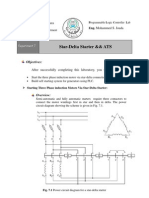Professional Documents
Culture Documents
Homopolar Generator
Uploaded by
Boreda RahulOriginal Description:
Copyright
Available Formats
Share this document
Did you find this document useful?
Is this content inappropriate?
Report this DocumentCopyright:
Available Formats
Homopolar Generator
Uploaded by
Boreda RahulCopyright:
Available Formats
Homopolar generator
From Wikipedia, the free encyclopedia
A homopolar generator is a DC electrical generator comprising an electrically conductive disc rotating in a plane perpendicular to a uniform static magnetic field. A potential difference is created between the center of the disc and the rim, the electrical polarity depending on the direction of rotation and the orientation of the field. It is also known as a unipolar generator, acyclic generator, disk dynamo, or Faraday disc. The voltage is typically low, on the order of a few volts in the case of small demonstration models, but large research generators can produce hundreds of volts, and some systems have multiple generators in series to produce an even larger voltage.[1] They are unusual in that they can source tremendous electric current, some more than a million amperes, because the homopolar generator can be made to have very low internal resistance.
Faraday disk, the first homopolar generator
Contents
[hide]
1 The Faraday disc 2 Homopolar generator development 3 Description and operation
o
generator
3.1 Disk-type
o
generator
3.2 Drum-type
4 Astrophysical unipolar
inductors 5 Physics 6 See also 7 External references 8 References and further reading
o o o
8.1 Notes 8.2 General references 8.3 Further reading 9 External links
[edit]The
Faraday disc
Faraday disc
The homopolar generator was developed first by Michael Faraday during his experiments in 1831. It is frequently called the Faraday disc in his honor. It was the beginning of modern dynamos that is, electrical generators which operate using a magnetic field. It was very inefficient and was not used as a practical power source, but it showed the possibility of generating electric power using magnetism, and led the way for commutated direct current dynamos and then alternating current alternators. The Faraday disc was primarily inefficient due to counterflows of current. While current flow was induced directly underneath the magnet, the current would circulate backwards in regions outside the influence of the magnetic field. This counterflow limits the power output to the pickup wires, and induces waste heating of the copper disc. Later homopolar generators would solve this problem by using an array of magnets arranged
around the disc perimeter to maintain a steady field radially from axis to edge, and eliminate areas where counterflow could occur.
[edit]Homopolar
generator development
The remains of the ANU 500 MJ generator
Long after the original Faraday disc had been abandoned as a practical generator, a modified version combining the magnet and disc in a single rotating part (the rotor) was developed. Sometimes the name homopolar generator is reserved for this configuration. One of the earliest patents on the general type of homopolar generators was attained by A. F. Delafield,U.S. Patent 278,516. Other early patents for homopolar generators were awarded to S. Z. De Ferranti and C. Batchelor separately. Nikola Tesla was interested in the Faraday disc and conducted work with homopolar generators. [2] He eventually patented an improved version of the device and his US patent ("Dynamo Electric Machine") describes an arrangement of two parallel discs with separate, parallel shafts, joined like pulleys by a metallic belt. Each disc had a field that was the opposite of the other, so that the flow of current was from the one shaft to the disc edge, across the belt to the other disc edge and to the second shaft. This would have greatly reduced the frictional losses caused by sliding contacts by allowing both electrical pickups to interface with the shafts of the two disks rather than at the shaft and a highspeed rim. Later, patents were awarded to C. P. Steinmetz and E. Thomson for their work with homopolar generators. The Forbes dynamo, developed by the Scottish electrical engineer George Forbes, was in widespread use during the beginning of the 20th century. Much of the development done in homopolar generators was patented by J. E. Noeggerath and R. Eickemeyer. Homopolar generators underwent a renaissance in the 1950s as a source of pulsed power storage. These devices used heavy disks as a form of flywheel to store mechanical energy that could be quickly dumped into an experimental apparatus. An early example of this sort of device was built by Sir Mark Oliphant at the Research School of Physical Sciences and Engineering, Australian National University. It stored up to 500 megajoules of energy[3] and was used as an extremely high-current source for synchrotron experimentation
from 1962 until it was disassembled in 1986. Oliphant's construction was capable of supplying currents of up to 2 megaamperes (MA). Similar devices of even larger size are designed and built by Parker Kinetic Designs (formerly OIME Research & Development) of Austin. They have produced devices for a variety of roles, from powering railguns to linear motors (for space launches) to a variety of weapons designs. Industrial designs of 10 MJ were introduced for a variety of roles, including electrical welding.[4] For more details on this topic, see List of homopolar generator patents.
[edit]Description [edit]Disk-type
and operation
generator
Basic Faraday disc generator
This device consists of a conducting flywheel rotating in a magnetic field with one electrical contact near the axis and the other near the periphery. It has been used for generating very high currents at low voltages in applications such as welding, electrolysis and railgun research. In pulsed energy applications, the angular momentum of the rotor is used to store energy over a long period and then release it in a short time. In contrast to other types of generators, the output voltage never changes polarity. The charge separation results from the Lorentz force on the free charges in the disk. The motion is azimuthal and the field is axial, so the electromotive force is radial. The electrical contacts are usually made through a "brush" or slip ring, which results in large losses at the low voltages generated. Some of these losses can be reduced by using mercury or other easily liquified metal or alloy (gallium, NaK) as the "brush", to provide essentially uninterrupted electrical contact. If the magnetic field is provided by a permanent magnet, the generator works regardless of whether the magnet is fixed to the stator or rotates with the disc. Before the discovery of the electron and the Lorentz force law, the phenomenon was inexplicable and was known as theFaraday paradox.
[edit]Drum-type
generator
A drum-type HPG has a magnetic field (B) that radiates radially from the center of the drum and induces voltage (V) down the length of the drum. A conducting drum spun from above in the field of a "speaker" type of magnet that has one pole in the center of the drum and the other pole surrounding the drum could use conducting ball bearings at the top and bottom of the drum to pick up the generated current.
[edit]Astrophysical
unipolar inductors
Unipolar inductors occur in astrophysics where a conductor rotates through a magnetic field, for example, the movement of the highly conductive plasma in a cosmic body's ionosphere through its magnetic field. In their book, Cosmical Electrodynamics, Hannes Alfvn andCarl-Gunne Flthammar write: "Since cosmical clouds of ionized gas are generally magnetized, their motion produces induced electric fields [..] For example the motion of the magnetized interplanetary plasma produces electric fields that are essential for the production of aurora and magnetic storms" [..] ".. the rotation of a conductor in a magnetic field produces an electric field in the system at rest. This phenomenon is well known from laboratory experiments and is usually called 'homopolar ' or 'unipolar' induction. [5] Unipolar inductors have been associated with the aurorae on Uranus,[6] binary stars,[7][8] black holes,
[9][10]
galaxies,[11] the Jupiter Io system,[12][13] the Moon,[14][15] the Solar Wind,[16] sunspots,[17][18] and in
the Venusian magnetic tail.[19]
[edit]Physics
Like all dynamos, the Faraday disc converts kinetic energy to electrical energy. This machine can be analysed using Faraday's own law ofelectromagnetic induction. This law (in its modern form) states that an electric current is induced in a closed electrical circuit when the magnetic flux enclosed by the circuit changes (in either magnitude or direction). For the Faraday disk it is necessary, however, to consider that the circuit(s) consist of each radial "spoke" of the disk connected to the rim and center and then through the external circuit. The Lorentz force law is more easily used to explain the machine's behaviour. This law, discovered thirty years after Faraday's death, states that the force on an electron is proportional to the cross product of its velocity and the magnetic flux vector. In geometrical terms, this means that the force is at right-angles to both the velocity (azimuthal) and the magnetic flux (axial), which is therefore in a radial direction. The radial movement of the electrons in the disc produces a charge separation between the center of the disc and its rim, and if the circuit is completed an electric current will be produced.[20]
You might also like
- Thermodynamics 2Document7 pagesThermodynamics 2riez24No ratings yet
- Superlight A Dynamic Aether Explains Pushing Gravity and InertiaDocument4 pagesSuperlight A Dynamic Aether Explains Pushing Gravity and InertiaMario FerreroNo ratings yet
- Ether Physics PDFDocument2 pagesEther Physics PDFAshley0% (1)
- The Marcus Device ControversyDocument8 pagesThe Marcus Device ControversyaasdasNo ratings yet
- Tesla WritingsDocument3 pagesTesla WritingsAngela AndersonNo ratings yet
- Townsend DischargeDocument4 pagesTownsend DischargeRonald Malave100% (1)
- Millimeter WavesDocument6 pagesMillimeter WavesbhaskarsgNo ratings yet
- AlzofonDocument20 pagesAlzofonOrphiac IncNo ratings yet
- And 1he ''Phii - Adelphia Expfriment': Negative TimeDocument94 pagesAnd 1he ''Phii - Adelphia Expfriment': Negative TimegospodarmunjaNo ratings yet
- The MR Preva ExperimentDocument5 pagesThe MR Preva ExperimentMihai Daniel100% (2)
- Philadelphia ExperimentDocument97 pagesPhiladelphia Experimentschlemihl69No ratings yet
- The Discovery of Electron Waves: Nobel Lecture, December 13, 1937Document8 pagesThe Discovery of Electron Waves: Nobel Lecture, December 13, 1937NeerajPalNo ratings yet
- Bearden - Tech Papers - Fogal Transistor Notes and ReferenceDocument29 pagesBearden - Tech Papers - Fogal Transistor Notes and Referencelightingfastno808No ratings yet
- Energy AccumulatorDocument2 pagesEnergy Accumulator47jarvNo ratings yet
- Lorenz, Lorentz, and The Gauge: Robert Nevels Chang-Seok ShinDocument3 pagesLorenz, Lorentz, and The Gauge: Robert Nevels Chang-Seok ShinSofi Obando VasquezNo ratings yet
- Einsteins Unified Field Theory & Biefeld-Brown EffectDocument4 pagesEinsteins Unified Field Theory & Biefeld-Brown EffectzorrinNo ratings yet
- The Classic Tesla Coil - A Dual-Tuned Resonant TransformerDocument3 pagesThe Classic Tesla Coil - A Dual-Tuned Resonant TransformerFatima FróisNo ratings yet
- Electro Gravitic S Electrokinetic S Val OneDocument10 pagesElectro Gravitic S Electrokinetic S Val OneshahpinkalNo ratings yet
- Searl John Roy Robert - The Epic Story of Free EnergyDocument14 pagesSearl John Roy Robert - The Epic Story of Free Energyertipole2No ratings yet
- Ion Ocr AftDocument25 pagesIon Ocr AftartleaderNo ratings yet
- Mueller Experiments Kromrey Brandt Tesla Bedini!!!!!Document30 pagesMueller Experiments Kromrey Brandt Tesla Bedini!!!!!d4nk4rNo ratings yet
- In A 1929 Article OnDocument10 pagesIn A 1929 Article OnAlexandra Adriana RaduNo ratings yet
- Quantum Vacuum Plasma Thruster.Document9 pagesQuantum Vacuum Plasma Thruster.justforaspinNo ratings yet
- Correspondence 030706 - MaxwellDocument9 pagesCorrespondence 030706 - Maxwellgong688665No ratings yet
- Tesla Symp06 CorumDocument7 pagesTesla Symp06 CorumNO,NO,NO 2 status QUONo ratings yet
- Benitez Redrawn 1918 Patent DiagramDocument1 pageBenitez Redrawn 1918 Patent DiagramDilJalaayNo ratings yet
- Panacea-BOCAF On-Line University: Contact UsDocument8 pagesPanacea-BOCAF On-Line University: Contact Ussymo121No ratings yet
- Strahlenfolter Stalking - Sind Radiofrequenzwaffen Der Sputnik Der 80er JahreDocument7 pagesStrahlenfolter Stalking - Sind Radiofrequenzwaffen Der Sputnik Der 80er JahreParanoia.war.gesternNo ratings yet
- Astral SubstanceDocument14 pagesAstral SubstanceMariaGrazia PirruccioNo ratings yet
- Gray 4595975Document7 pagesGray 4595975MANNAJANELAGUNANo ratings yet
- THE Tesla Theory: World'S History andDocument8 pagesTHE Tesla Theory: World'S History andAbia Annieson A. Lorenzo100% (1)
- The Genesis Project PDFDocument19 pagesThe Genesis Project PDFvikas kansalNo ratings yet
- Welcome To Bedini TechnologyDocument1 pageWelcome To Bedini TechnologyCarlos JuniorNo ratings yet
- Electromag and ElectrostaticsDocument29 pagesElectromag and ElectrostaticsChristine MalibiranNo ratings yet
- Electromagnetic LevitatorDocument20 pagesElectromagnetic LevitatorPramote RodbonNo ratings yet
- ZPF Pervasive EMDocument7 pagesZPF Pervasive EMIndranu NuNo ratings yet
- Zero Point Energy Free Energy Spirituality Amp ConsciousnessDocument3 pagesZero Point Energy Free Energy Spirituality Amp ConsciousnessPeter Pinter100% (1)
- PerendevDocument9 pagesPerendevMariano SorrentinoNo ratings yet
- Nikola Tesla and Albert EinsteinDocument3 pagesNikola Tesla and Albert EinsteinbimbaqNo ratings yet
- Light: Electromagnetic Radiation Light (Disambiguation) Visible Light (Disambiguation)Document19 pagesLight: Electromagnetic Radiation Light (Disambiguation) Visible Light (Disambiguation)AnandNo ratings yet
- AIAA Agnew WarpDrive Final PDFDocument15 pagesAIAA Agnew WarpDrive Final PDFmisterNo ratings yet
- Hendershot BookDocument52 pagesHendershot BookboboNo ratings yet
- Prentice Earth Energy TapDocument7 pagesPrentice Earth Energy TapGeorggeNo ratings yet
- Quest For Zero-Point Energy: Engineering Principles For "Free Energy"Document5 pagesQuest For Zero-Point Energy: Engineering Principles For "Free Energy"Manish ShahNo ratings yet
- Bedini Motor Open SourceDocument2 pagesBedini Motor Open Sourceslavkobatich100% (1)
- ENEL427 - Final Report - Pnr22 - Tesla CoilDocument19 pagesENEL427 - Final Report - Pnr22 - Tesla CoilPeter RueNo ratings yet
- BEDINI DRAWNS Report On 4 Battery SwitchDocument31 pagesBEDINI DRAWNS Report On 4 Battery SwitchMANNAJANELAGUNA0% (1)
- Piezo Zero PointDocument36 pagesPiezo Zero PointAdam MoesNo ratings yet
- Bearden - Electret - What It Is and How It Works (2005) PDFDocument4 pagesBearden - Electret - What It Is and How It Works (2005) PDFUn Chubacca YetiNo ratings yet
- Inventions, Researches and Writings of Nikola Tesla: Including Tesla's AutobiographyFrom EverandInventions, Researches and Writings of Nikola Tesla: Including Tesla's AutobiographyNo ratings yet
- The Black Hole Experiments Quadrilogy (2014)From EverandThe Black Hole Experiments Quadrilogy (2014)Rating: 5 out of 5 stars5/5 (8)
- Stanley Meyer Big Bobbin Builders Guide 2019 v1: Very Rare Guide for How to Assemble Water Fueled injector tri-filar bobbinFrom EverandStanley Meyer Big Bobbin Builders Guide 2019 v1: Very Rare Guide for How to Assemble Water Fueled injector tri-filar bobbinNo ratings yet
- Recent Developments in Switching TheoryFrom EverandRecent Developments in Switching TheoryAmar MukhopadhyayNo ratings yet
- Nineteenth-Century Aether Theories: The Commonwealth and International Library: Selected Readings in PhysicsFrom EverandNineteenth-Century Aether Theories: The Commonwealth and International Library: Selected Readings in PhysicsRating: 5 out of 5 stars5/5 (1)
- Amf Panel Spec (1) .Document7 pagesAmf Panel Spec (1) .Boreda RahulNo ratings yet
- Ltesa Ais Catalogue-VcbDocument20 pagesLtesa Ais Catalogue-VcbSharafat AliNo ratings yet
- Is 694Document13 pagesIs 694flngoff641950% (2)
- New Microsoft Office Word DocumentDocument1 pageNew Microsoft Office Word DocumentBoreda RahulNo ratings yet
- STAR DELTA Connection Diagram and Working PrincipleDocument2 pagesSTAR DELTA Connection Diagram and Working PrinciplePrasant Kumar100% (5)
- L&T MCCB Product CatalougeDocument84 pagesL&T MCCB Product CatalougeKishore Krishna92% (13)
- Power Capacitors and Reactive Power Management Products CatalogueDocument28 pagesPower Capacitors and Reactive Power Management Products CatalogueBoreda RahulNo ratings yet
- Lab 54Document7 pagesLab 54ËMüsh ÅBäyNo ratings yet
- Concept of Three Phase and Single Phase - Electrical Engineering CenterDocument2 pagesConcept of Three Phase and Single Phase - Electrical Engineering CenterBoreda RahulNo ratings yet
- Technical Guide XenergyDocument64 pagesTechnical Guide XenergyBoreda RahulNo ratings yet
- Different Types of Earthing Devices - Electrical Engineering CenterDocument4 pagesDifferent Types of Earthing Devices - Electrical Engineering CenterBoreda RahulNo ratings yet
- Relationship Between Current and Voltage in Various System Components - Electrical Engineering CenterDocument2 pagesRelationship Between Current and Voltage in Various System Components - Electrical Engineering CenterBoreda RahulNo ratings yet
- Panel Busbar Sizing Calculations - Thomas and RataDocument4 pagesPanel Busbar Sizing Calculations - Thomas and Ratakapil100% (12)
- Cal 00 e 0004 Rev 1 Electrical Cable SizingDocument5 pagesCal 00 e 0004 Rev 1 Electrical Cable SizingBoreda RahulNo ratings yet
- Control of Machines PDFDocument355 pagesControl of Machines PDFWrya Saeed100% (1)
- Designanddevelopmentofautotransformermotorstarterforinduceddraftfanidfofbatangassugarcentralinc 131214044449 Phpapp01Document14 pagesDesignanddevelopmentofautotransformermotorstarterforinduceddraftfanidfofbatangassugarcentralinc 131214044449 Phpapp01Boreda RahulNo ratings yet
- Electricaldevices 131106081719 Phpapp01Document19 pagesElectricaldevices 131106081719 Phpapp01Boreda RahulNo ratings yet
- Protection & Coordination - Motor ProtectionDocument34 pagesProtection & Coordination - Motor ProtectionAdelChNo ratings yet
- Cables Installation Methods - Electrical Engineering CenterDocument3 pagesCables Installation Methods - Electrical Engineering CenterBoreda RahulNo ratings yet
- Questions and Answers About - Motors - For Electrician's Examinations - Electrical Engineering CenterDocument9 pagesQuestions and Answers About - Motors - For Electrician's Examinations - Electrical Engineering CenterBoreda RahulNo ratings yet
- Electrical and Communication Engineering Sample ResumeDocument2 pagesElectrical and Communication Engineering Sample ResumeNaresh KumarNo ratings yet
- Details of State Pension SchemesDocument30 pagesDetails of State Pension SchemesBoreda RahulNo ratings yet
- Siemens Motor - Control - CentersDocument80 pagesSiemens Motor - Control - Centersmarf123No ratings yet
- Exp 72ats PDFDocument4 pagesExp 72ats PDFOdipiyo Paul100% (1)
- Lab 54Document7 pagesLab 54ËMüsh ÅBäyNo ratings yet
- Control of Machines PDFDocument355 pagesControl of Machines PDFWrya Saeed100% (1)
- Applicable PDFDocument1 pageApplicable PDFnaval210No ratings yet
- Applicable PDFDocument1 pageApplicable PDFnaval210No ratings yet
- Ehv Circuit BreakersDocument12 pagesEhv Circuit BreakersBoreda RahulNo ratings yet
- Internal Electrification Work For Cray Technical SpecificationDocument16 pagesInternal Electrification Work For Cray Technical SpecificationDharmendra ShahNo ratings yet
- Tutorial Getting Started With Code Aster PDFDocument12 pagesTutorial Getting Started With Code Aster PDFEnriqueNo ratings yet
- Kuo SzuYu 2014 PHD ThesisDocument261 pagesKuo SzuYu 2014 PHD ThesiskatandeNo ratings yet
- Leverage My PptsDocument34 pagesLeverage My PptsMadhuram SharmaNo ratings yet
- Handling Qualites of CanardDocument49 pagesHandling Qualites of CanardUsman GhummanNo ratings yet
- Case Study Method: Dr. Rana Singh MBA (Gold Medalist), Ph. D. 98 11 828 987Document33 pagesCase Study Method: Dr. Rana Singh MBA (Gold Medalist), Ph. D. 98 11 828 987Belur BaxiNo ratings yet
- Chapter 8 Review QuestionsDocument2 pagesChapter 8 Review QuestionsSouthernGurl99No ratings yet
- Merger of Bank of Karad Ltd. (BOK) With Bank of India (BOI)Document17 pagesMerger of Bank of Karad Ltd. (BOK) With Bank of India (BOI)Alexander DeckerNo ratings yet
- An Aging Game Simulation Activity For Al PDFDocument13 pagesAn Aging Game Simulation Activity For Al PDFramzan aliNo ratings yet
- An Objective of Dress Code PolicyDocument4 pagesAn Objective of Dress Code PolicySiddhraj Singh KushwahaNo ratings yet
- Emotions Influence Color Preference PDFDocument48 pagesEmotions Influence Color Preference PDFfllorinvNo ratings yet
- G.R. No. 201354 September 21, 2016Document11 pagesG.R. No. 201354 September 21, 2016Winston YutaNo ratings yet
- Laurel VS GarciaDocument2 pagesLaurel VS GarciaRon AceNo ratings yet
- Summary of All Sequences For 4MS 2021Document8 pagesSummary of All Sequences For 4MS 2021rohanZorba100% (3)
- Prayer For Stages On The PathDocument6 pagesPrayer For Stages On The PathEijō JoshuaNo ratings yet
- English Reading Kit Level 1: Pupil's Assessment ManualDocument15 pagesEnglish Reading Kit Level 1: Pupil's Assessment ManualGretylle Quicoy100% (1)
- Analgesic ActivityDocument4 pagesAnalgesic ActivitypranaliankitNo ratings yet
- 07.03.09 Chest PhysiotherapyDocument10 pages07.03.09 Chest PhysiotherapyMuhammad Fuad MahfudNo ratings yet
- How To Manage Asthma: A GuideDocument44 pagesHow To Manage Asthma: A GuideSrinivas YerriboinaNo ratings yet
- FS 1 Activity 3.3Document6 pagesFS 1 Activity 3.3HYACINTH GALLENERONo ratings yet
- Lee. Building Balanced Scorecard With SWOT Analysis, and Implementing "Sun Tzu's The Art of Business Management Strategies" On QFD Methodology PDFDocument13 pagesLee. Building Balanced Scorecard With SWOT Analysis, and Implementing "Sun Tzu's The Art of Business Management Strategies" On QFD Methodology PDFSekar Ayu ParamitaNo ratings yet
- Working With Regular Expressions: Prof. Mary Grace G. VenturaDocument26 pagesWorking With Regular Expressions: Prof. Mary Grace G. VenturaAngela BeatriceNo ratings yet
- 02 - Nature and Role of Science in SocietyDocument10 pages02 - Nature and Role of Science in SocietyMarcos Jose AveNo ratings yet
- 1 2 4 Ak Sequentiallogicdesign Counters DLBDocument7 pages1 2 4 Ak Sequentiallogicdesign Counters DLBapi-290804719100% (1)
- Taschen Tradecat 2014 01 Tam 1402181720 Id 775697 PDFDocument57 pagesTaschen Tradecat 2014 01 Tam 1402181720 Id 775697 PDFLuiza Oliveira100% (1)
- PHNCDocument6 pagesPHNCAmit MangaonkarNo ratings yet
- Chuyen de GerundifninitiveDocument7 pagesChuyen de GerundifninitiveThao TrinhNo ratings yet
- What If The Class Is Very BigDocument2 pagesWhat If The Class Is Very BigCamilo CarantónNo ratings yet
- Schemes and Tropes HandoutDocument6 pagesSchemes and Tropes HandoutJohn LukezicNo ratings yet
- Potential Nursing Diagnosis Problem Fdar / NCP: Activity # 2Document2 pagesPotential Nursing Diagnosis Problem Fdar / NCP: Activity # 2Karl KiwisNo ratings yet
- Remarkings AirportsDocument1 pageRemarkings AirportsJuan Jose CaleroNo ratings yet








